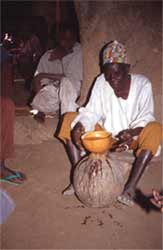Regional History of Slavery
The history of slavery is linked with the history of Islam in the region, which goes back about a thousand years. Beginning with Kanem and Borno
and since the 16th century, the Sultanate of Mandara, it reached its historical peak in the 19th century with the Fulbe conquering the central plateau south of Mokolo.
There is still a vivid memory of the times of slavery among many older people of the Northern Mandaras. Being sold into slavery was a matter of local involvment and it was not uncommon that somebody of the same family was given away into slavery by other members of his family (Kosack 1992).
The Mandara
The Sultate Manara was the historically most important slave raiding society of the Northern Mandaras. There is good evidence that the Mandara had created a tribute system (Forkl 1983:292ff) which forced many montagnard groups to raid among themselves in order to “pay” their human dues. When they failed to do so the Mandara resumed raiding. Their influence covered, for several hundred years, the whole of Northern Mandaras (Mohammadou 1982).
The Fulbe
The Fulbe system of enslavement was driven not so much by a trbute system but more by religious motives which doesn’t mean that they were not in need of slaves. In 1810 Modibbo Adama encouraged the regional Fulbe chiefs to launch the jihad agains all pagan populations (Mohammadou 1988:257-64). Defense system built as stone walls by the montagnards against the attacking Fulbe cavalary stem from this time, as reported by Vincent (1991:94ff) on the Mofu-Diamare.
Hamman Yaji
Hamman Yaji, a Fulbe, was the last slave raider of the Northern Mandaras. He was arrested by the British in 1927 and montagnards from Sukur to Dughwede give explicite accounts on his relentless raiding. His diary was published in 1995 (Vaughan et al). It is historically unclear whether it was the suspicion of Mahdism or the complains from montagnards which led to his arrest (Muller-Kosack 1999).
